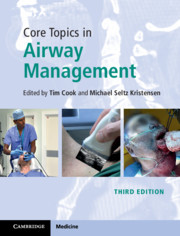Book contents
- Core Topics in Airway Management
- Core Topics in Airway Management
- Copyright page
- Contents
- Contributors
- Foreword
- Preface to the Third Edition
- Section 1 Airway Management: Background and Techniques
- Section 2 Airway Management: Clinical Settings and Subspecialties
- Chapter 22 The Airway in Obstetrics
- Chapter 23 The Paediatric Airway
- Chapter 24 Airway Management in Obesity
- Chapter 25 Maxillofacial and Dental Surgery
- Chapter 26 Ear, Nose and Throat Surgery: Airway Management
- Chapter 27 Lung Separation
- Chapter 28 Airway Management in the Critically Ill
- Chapter 29 The Patient with a Tracheostomy
- Chapter 30 Pre-hospital and Trauma Airway Management
- Chapter 31 Airway Management during CPR
- Chapter 32 The Bloody and Bleeding Airway
- Chapter 33 The Airway in Anaesthesia for Transoral Robotic Surgery
- Section 3 Airway Management: Organisation
- Index
- References
Chapter 28 - Airway Management in the Critically Ill
from Section 2 - Airway Management: Clinical Settings and Subspecialties
Published online by Cambridge University Press: 03 October 2020
- Core Topics in Airway Management
- Core Topics in Airway Management
- Copyright page
- Contents
- Contributors
- Foreword
- Preface to the Third Edition
- Section 1 Airway Management: Background and Techniques
- Section 2 Airway Management: Clinical Settings and Subspecialties
- Chapter 22 The Airway in Obstetrics
- Chapter 23 The Paediatric Airway
- Chapter 24 Airway Management in Obesity
- Chapter 25 Maxillofacial and Dental Surgery
- Chapter 26 Ear, Nose and Throat Surgery: Airway Management
- Chapter 27 Lung Separation
- Chapter 28 Airway Management in the Critically Ill
- Chapter 29 The Patient with a Tracheostomy
- Chapter 30 Pre-hospital and Trauma Airway Management
- Chapter 31 Airway Management during CPR
- Chapter 32 The Bloody and Bleeding Airway
- Chapter 33 The Airway in Anaesthesia for Transoral Robotic Surgery
- Section 3 Airway Management: Organisation
- Index
- References
Summary
Many studies from around the world, especially NAP4 in the UK, have demonstrated that airway management in critically ill patients, whether in the intensive care unit, emergency department or general wards, is fraught with danger. Serious morbidity or mortality may be 50-fold more common than in anaesthetic practice. This chapter describes the essential features of airway management specific to critical care intubation. The importance of an intubation bundle approach is emphasised, such as the UK’s Difficult Airway Society guidelines for tracheal intubation in the critically ill adult. Components include: (i) deliberate and thoughtful application of human factors science to optimise team performance and sharing the airway plan; (ii) assessment of potential difficulty based on the MACOCHA scoring system; (iii) pre-oxygenation using continuous positive airway pressure (CPAP) or non-invasive ventilation, high flow nasal oxygen, or a combination of these; (iv) a modified rapid sequence induction with continuous peroxygenation; (v) optimising laryngoscopy and intubation with early videolaryngoscopy by a trained operator; (vi) airway rescue with an amalgamated Plan B/C, borrowing from the Vortex approach; (vii) use of second generation supraglottic airways (SGAs); (viii) priming for front of neck airway (FONA) and (ix) a scalpel-bougie-tube cricothyroidotomy when managing cannot intubate, cannot oxygenate (CICO).
- Type
- Chapter
- Information
- Core Topics in Airway Management , pp. 250 - 258Publisher: Cambridge University PressPrint publication year: 2020

